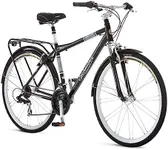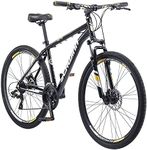Buying Guide for the Best Men's Comfort Bikes
Choosing the right men's comfort bike involves understanding your specific needs and preferences. Comfort bikes are designed for casual riding, offering a relaxed and upright riding position. They are perfect for leisurely rides around the neighborhood, commuting, or light trail use. To find the best fit for you, consider the following key specifications and how they align with your intended use and comfort requirements.Frame MaterialThe frame material of a bike affects its weight, durability, and ride quality. Common materials include aluminum, steel, and carbon fiber. Aluminum frames are lightweight and resistant to rust, making them a popular choice for comfort bikes. Steel frames are heavier but offer a smoother ride due to their flexibility. Carbon fiber frames are the lightest and provide excellent shock absorption but are typically more expensive. Choose a frame material based on your preference for weight, ride quality, and budget.
SuspensionSuspension systems on comfort bikes help absorb shocks from rough terrain, providing a smoother ride. There are two main types: front suspension (suspension fork) and full suspension (both front and rear). Front suspension is common in comfort bikes and is sufficient for most casual riders, as it helps with bumps and uneven surfaces. Full suspension offers more comfort but adds weight and complexity. If you plan to ride on very rough trails, consider full suspension; otherwise, front suspension should be adequate.
Wheel SizeWheel size affects the bike's handling and comfort. The most common wheel sizes for comfort bikes are 26-inch and 700c. 26-inch wheels are smaller, making the bike more maneuverable and easier to handle, especially for shorter riders. 700c wheels are larger, providing a smoother ride and better efficiency on paved surfaces. Choose a wheel size based on your height and the type of terrain you plan to ride on.
GearingGearing determines how easy it is to pedal the bike on different terrains. Comfort bikes typically come with a range of gears, from single-speed to multi-speed options. Single-speed bikes are simple and low-maintenance, ideal for flat terrain and short rides. Multi-speed bikes offer more versatility, allowing you to tackle hills and varied terrain with ease. Consider your riding environment and physical fitness when choosing the gearing; more gears provide greater flexibility but can add complexity.
BrakesBrakes are crucial for safety and control. The two main types are rim brakes and disc brakes. Rim brakes are lighter and easier to maintain, making them suitable for casual riding on flat terrain. Disc brakes offer better stopping power and performance in wet or muddy conditions, making them ideal for varied terrain and more demanding rides. Choose brakes based on your riding conditions and preference for maintenance.
SaddleThe saddle, or seat, greatly affects your comfort while riding. Comfort bikes typically feature wider, more cushioned saddles to provide support during leisurely rides. Some saddles also have springs or gel padding for added comfort. Test different saddles to find one that feels comfortable for your body shape and riding style. Remember that saddle comfort is highly personal, so what works for one person may not work for another.
HandlebarsHandlebars on comfort bikes are designed to provide an upright riding position, reducing strain on your back and shoulders. Common types include flat bars, riser bars, and swept-back bars. Flat bars offer a straightforward, stable grip, while riser bars provide a higher hand position for better visibility and control. Swept-back bars allow for a more relaxed, natural hand position. Choose handlebars that feel comfortable and provide the right balance of control and relaxation for your riding style.











